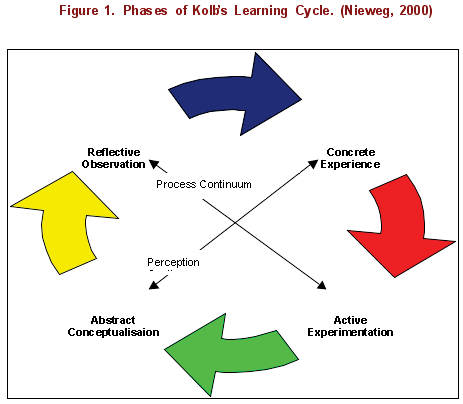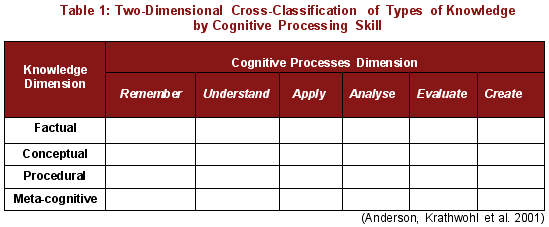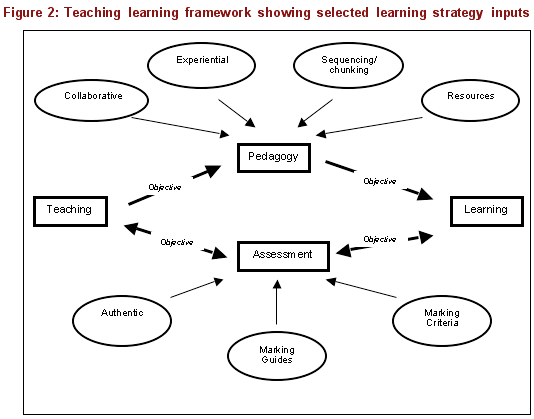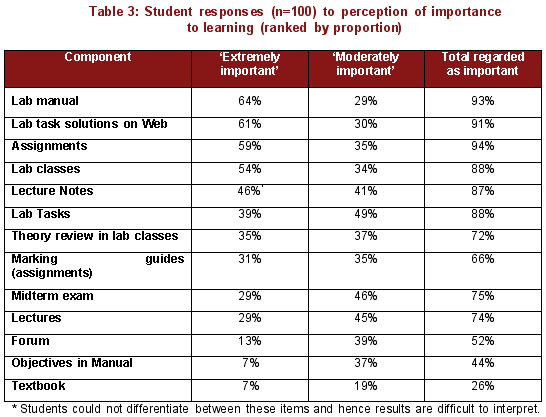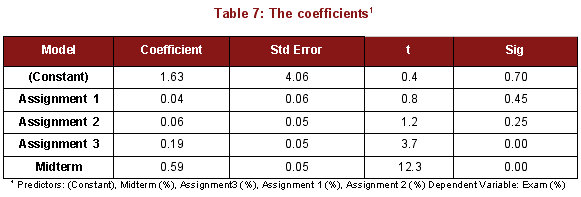|
Assessment Is Bloomin Luverly: Developing Assessment That Enhances LearningMaureen Morris, Anne Porter and David GriffithsUniversity of Wollongongmm00@uow.edu.auAbstract
IntroductionIn any instructional process, one of the fundamental questions that is continually asked by the teacher remains: "But how will I know when they understand the concepts." This question has long been posed and has formed the crux of the dilemma facing practitioners today. But if this is a problem for the educators themselves, it is mirrored in the minds and hearts of students the world over. How do they know just what are the knowledge and skills required of them and how do they show that they have acquired them? This study was born of the teachers' earnest attempts to provide focused assessment that did indeed assess what it claimed to assess, and also provided 'signposts' for the learning of her students. Such focused assessment could afford a guiding framework for teaching and a powerful learning tool for students. There have been recent large-scale changes in syllabi in the state high school system of N.S.W. and in the United States founded on outcome-based learning and assessment, but relatively little evidence of this approach exists in our universities. Many courses are content based, with 'lip service' paid to outcomes only evident in a broad specification within unit outlines. To design a framework for guiding both teaching and learning has required consideration of:
The framework needed to be developed in the context of the globally defined graduate outcomes and through defined course content. As the problem that arises in the classroom, the classroom should provide an appropriate venue for its resolution. Action research affords an appropriate methodology for this type of study. (Gomm, 2004) The participant researchers' collective experiences, observations, reflections and analyses of practice in previous implementations of the research cycle, were used to identify the successful strategies and student needs. These form the starting point for this study of a first year statistics program and its assessment. Following the development of an appropriate model and its subsequent implementation:
Theoretical backgroundLearning theoriesThe processes of student learning require due attention in designing assessment that aligns with all aspects of teaching and learning. The three main theories of learning are:
The construction of the learning framework has been supported by what the researcher's have perceived as compatible with the three main learning theories. However, the primary researcher's social constructivist perspective may still possibly be discerned. Decisions were made after surveying the types of strategies used by devotees of each of the three theories and still others not reported in this paper. Anderson and Elloumi et al (2004) provide a structured outline of the required theoretical background. Behaviourism perceives learning as resulting in changes in behaviour. Some behaviourist considerations which could be implemented could include:
The cognitive approach regards learning from the 'information processing' viewpoint and includes the aspects of motivation, memory, thinking and reflection. Practitioners see learning as taking place when knowledge is internally accommodated and personalized. From this stand, teaching should involve:
Constructivists view the teacher as the facilitator in the learning process. They believe that learning takes place as the student actively participates, interpreting, processing and constructing new knowledge. Because they see learning as contextual they consider it to be more effective in practical situations. In designing the pedagogy, consideration should be given to:
Motivation is fundamental to successful learning. It can be either intrinsic (derives from within the learner e.g. self satisfaction/sense of achievement) or extrinsic (usually generated by the instructor or course e.g. marks/grades, praise etc). Intrinsic motivation appears to be more powerful in eliciting deeper and life-long learning. (Avery 1999) Song and Keller (1999) proposed a model for motivating students that endeavoured to:
Any approach to learning needs to include strategies that will develop or enhance meta-cognitive skills. Although most intrinsically motivated students display these skills to some degree, any attempt to place students in charge of their own learning, needs to promote them.
Learning stylesIf the assessment is to be 'fair' to all students then it should offer appeal to all styles of learner. Kolb's experiential learning theory describes learning as taking place across two intersecting continua of perception and processing. He observed that learners appeared to demonstrate preferences for pairs of the phases of learning. These pairs of preferences lie at either end of either of the two continua.
Kolb described learners as:
However, the most enriching learning experiences afford the opportunity to all participants to work cyclically through all four phases. Tasks that expose students to all of these phases are more likely to stimulate deeper learning. (Kolb 1984; Nieweg 2000) Since interactive learning also supports deeper learning, tasks that allow collaboration, but still encourage independence and ingenuity need to be developed. The 'team' approach to assessment tasks also promotes confidence and pays more than 'lip service' to espoused graduate attributes that applaud 'community' values and 'sharing of talents'. (University of Wollongong, 2004) Tasks should also seek to use available technology as the community increasingly demands these skills of graduates and provide 'authentic' (Cobb, 1993; Avery, 1999; Evans, 1999; Prestidge and Glaser, 2000) or meaningful tasks which are modelled on those previously experienced.
Defining the learningEven defining such a supportive framework for learning, both teachers and students need to be aware of the knowledge and skills the students are expected to demonstrate, i.e. the expected learning should be clearly defined. It is such definition that has proved expeditious in student learning in the high school system. The aim here has been to explicitly align the expected learning with graduate attributes, course and unit outcomes, teaching objectives and pedagogy in clear statements of the objectives available to teacher and student alike. This alignment process focuses the subject delivery directly at student learning and it has become increasingly evident to the participant researchers that this process is fundamental to successful teaching/learning. Although we inform students of what they are expected to know, many are at a loss as to how they are to show such learning. The assessment tasks may be modelled on previous class work, but 'marking guides' may clarify what is expected and offer 'organizers' for responses. (Ivie 1998; Heady 2000; Prestidge and Glaser 2000; Romagnano 2001; Montgomery 2002) The 'guides' may be explicit in initial tasks, but become less so as student learning progresses. Careful thought needs to be given to inclusion of marks on these 'guidelines', as explicit and narrow alignment of marks with tasks may detract from the task as a learning tool. (Black, 1998) The 'guides' were given to students without the marks in order to offer structure for responses. This was because the premise held by the researchers that their inclusion would:
Fundamental to the design of a working framework that recognizes this theoretical background, is the statement of expected learning, i.e. the statement of the assessment objectives. Evaluation of student learning can be very subjective without some generalized frame of reference. Bloom and his associates pursued early research in this field. Their original intention was to devise a taxonomy of learning which would facilitate discussion by educators. Bloom's taxonomy offered a classification of knowledge and skills in what purported to be a hierarchical structure, highlighting representation of both higher and lower order knowledge and skills. Thus it became a useful tool for evaluation of assessment against teaching objectives. Framing the objectives in behavioural terms enabled observation of their achievement. (Bloom 1974) Such behavioural specification earned the taxonomy a great deal of criticism. Anderson, Krathwohl et al (2001) have highlighted some of the criticisms leveled at Bloom. They refer to claims that it was only useful in the realm of the behaviourists, recognizing learning as only in an altered pattern of behaviour. However this criticism fails to see the objective as a means towards recognizing learning rather than as the end in itself. They also discuss the criticism that it 'limited' recognition of achievement. Specificity in defining an objective may simplify assessment of its achievement, but may also cloud recognition of any more complex learning being exhibited. It can prove a challenging exercise to define creative achievement in the taxonomy's terms and its application may be less than reliable for different educators from different fields. (Anderson, Krathwohl et al. 2001) Anderson, Krathworl et al (2001) undertook a revision of Bloom's taxonomy, separating knowledge from the cognitive processing dimension to form a two-dimensional classification of knowledge and skills. They recognized the inherent lack of hierarchy in the taxonomy, but maintained that an evident hierarchy did exist within each classification. (Anderson, Krathwohl et al. 2001)
Although the revision of Bloom's taxonomy was chosen for this study, it is not the only classification tool available to educators. Another, the SOLO taxonomy, is closely aligned with the developmental stages of Piagetian theory. The taxonomy classifies learning into levels of increasing complexity. Learning at the lowest stage (pre-structural) does not recognize connections between pieces of information. Whereas at the highest level (extended abstract), connections are made not only in the current context but extend beyond. (Biggs and Collis 1982)
The learning frameworkIn the light of the surveyed theory, the learning framework has been chosen to include:
All facets of the subject's presentation and evaluation were aligned through the objectives. It is this process of alignment which appears to have underpinned any success which has been observed in implementing the selected framework. The targeted level of student learning was evaluated by 'coding' question of assessment tasks using the revised Boom's taxonomy, although this proved a less than reliable task.
ImplementationIn the subject that was the focus of this study, assessment was comprised of:
All were aligned with the objectives and with each other. The focus for this paper is the assignments. However alignment of all key components means that evaluation of the assignments involves due consideration to all facets of the subject which impact upon the teaching and learning.
The assignmentsStatements of the specific objectives accompanied each assignment together with a set of marking guides (no marks indicated) that provided students with indicators of desired outcomes and hence structures for responses. As students were presumed to have learned from previous assignments, the Marking Guidelines of the second and third assignments were less detailed. Students were required to use a statistical software package for data analysis and to word-process assignments, interweaving output with their own words. Assignments were completed in teams of two. Each assignment question was comprised of two parts and each member responded to one only. These parts were designed to complement or supplement each other, and team members were encouraged to collaborate and share responses, but present their own solution to their own part of the problem. They could not 'collaborate' with anyone other than their partner. For example, in Assignment 2, one student would complete questions dealing with a model from a Poisson distribution, generating expected frequencies for a sample based on the given model (working with theory). The partner would generate a random sample and answer questions based upon that sample and, using expected frequencies from their partner's output, would conduct a 'Goodness of Fit' Test for their sample (working with their simulated data). In the next question, the roles were reversed for a question dealing with the Binomial distribution. This approach ensured the need for collaboration. Student Evaluation responses indicate that the 'teamwork' appears to have promoted confidence in the students. It afforded opportunity for discussion and clarification of more complex tasks without having to surrender independence of response. The questions were aligned with appropriate laboratory tasks in order to reinforce prior learning. In an attempt to engage students in analysis of 'real' data, the tasks required access to data files generated from data collected through a web-based survey of the students themselves. The last assignment involved the student's personal collection of data in addition to its analysis. Attempting to exercise some measure of control over student assessment, tutors were cautioned about responding to questions relating to the assignments. They were instructed to direct students to appropriate lecture and laboratory material and not to model 'answers' with similar or related problems. This was to reduce the chance of diminishing the 'quality' of anticipated learning. Guided and repetitious performance demands far less of students than when minimal guidance is given. The marking criteria (not provided in advance to students) listed a set of targeted responses each of which was marked on a 0/1 scale. This facilitated prompt and detailed feedback that simply listed what had been achieved (one mark) and what had not (zero marks). Students have perceived the whole assessment process as 'pretty fair', since generally each student could potentially earn 'what they deserve' and be neither limited nor completely supported by the other member of the team. Weaker team members received some help in terms of collaborative discussion, but could not end up with their submission completed by another. There appeared to be little evidence of illegitimate 'collaboration' (branded as 'plagiarism' in the assignment preamble) outside the team structure. The teachers' perception is that such plagiarism appears to have been more prominent in previous approaches to assignments.
The laboratory classesThese classes provided collaborative and experiential learning exercises seen as imperative to learning and were conducted in computer rooms. The Lab manuals/workbooks contained the bulk of required learning materials, a course introduction, assignment specifications, objectives and tasks for each week, technical notes and PowerPoint slides of lecture material. Space was provided for pen-and-paper responses and to allow for students to paste in computer generated output. Thus students ultimately produced their own expanded workbook intended as a further valuable learning resource. Weekly tasks involved 'preparation' questions, data collection (both qualitative and quantitative), organization, analysis and interpretation of output. Whilst a tutor provided support and guidance, the tasks were designed to encourage student-centred learning. The team approach was actively encouraged, particularly in the initial classes. This ultimately led to a relaxed and collaborative learning environment. Tasks draw on different theoretical ideas such as loosening and tightening constructs to engender creative thinking and then to consolidate ideas (Kelly, 1955). Still other tasks involve experiential learning (Kolb 1984; Nieweg 2000), while some emphasise collaborative learning (White, 1995), activity based exercises using real data and authentic assessment (Cobb, 1993; Avery, 1999; Evans, 1999; Prestidge and Glaser, 2000), and some promoted the development of metacognitive skills through reflection on activities and frames and concept mapping (Turban, 1990; Novak and Gowin, 1984). The sequencing of tasks typically follow a listening, speaking, reading, and writing pattern. To promote continued learning outside class hours, the tasks were designed to be too long to be completed in class time. However, students worked phrenetically to complete each weekly task in class, resulting in a distorted perception of the workload. In future implementations this needs to be clarified with students to minimize stress. Marks were allocated (10%) for completion to maximum of 10 out of 12 labs. Worked solutions were later uploaded onto the Web. Because many students fell behind, they were encouraged to download solutions to complete the manual as they would be able to take this resource into the final exam. Most students realized eventually that output was of little use to them without some experience in its interpreting. The classes were busy but relaxed, with most students actively engaged at all times. Few students left the classes early, and although attendance was not compulsory, it remained stable, with most students appearing to recognize the relevance to the subject learning framework.
The midterm testThe test was based on material from the first three quarters of the course and provided an opportunity for students to approach an exam armed with their self-created and (hopefully) completed Lab manual as a guide to expected learning. Familiarity with the material and their previous classroom experience appeared to both relax and encourage optimism in appropriately prepared students.
The final examThe final exam was aligned with laboratory tasks and assignments. Students were permitted to take their completed laboratory manual into the exam as a reference. Because of the analytical approach taken in all facets of continuous assessment, questions represented a more interpretive and analytical approach than previously used in examinations in this subject. It was anticipated that students would find it more difficult than in previous years because of the increase in the higher order cognitive component. However students did appear more 'comfortable' with the subject and what was expected of them. Student Evaluations indicated lower stress levels ahead of the examination than had been evident in previous semesters.
EvaluationProcessStudent learning was evaluated through the summative measures of marks (assignments, lab marks, midterm, presentation and final exam marks). Students were also surveyed as to their attitudes to the components of the subject's delivery and the ranked level of importance to their learning. They chose from a set of specified scaled responses. Similarly they were also asked to select statements that reflected their level of learning in this subject. Qualitative data was also collected. Students nominated topics with which they felt 'comfortable' and those they found 'difficult' (open text) and described their attitudes to the 'fairness' of the assessment (open text). There was provision for further comment if they wished and some students volunteered to be interviewed personally. Triangulation of the data from all of these sources, together with attendance rates was to be used to support the belief that the framework had indeed enhanced student learning. (Bloor, 1997) Teaching staff were similarly surveyed.
Results: student attitudesOne hundred responded (from a total of 200 students enrolled). The following chart summarises students' responses to which aspects of the learning environment were regarded as extremely important or moderately important to their learning. The table lists the responses ordered by proportion of respondents.
Students have indicated the importance of the Lab manual as a focus for completion of all assessment. It is also the only resource that they may take into the final exam, so they have worked diligently to complete it. The results indicate the value students have placed on active and collaborative learning experiences. They have perceived the assignments as strongly influencing their learning, but show their need for the detailed feedback to be found in worked solutions. They still appreciate the small group 'teaching' (Theory review) of the tutor in lab classes, but also view the lecture notes as guides to essential content. Marking guides do not rate as highly as had been expected, but this may have been because it was an innovation and students appear to rarely read all of the preamble in assignments. Most students, however, felt that they had improved their achievement in assignments by using the Marking guides and hence they were considered as moderately to extremely important by 66% of respondents. Although many students claimed not to have used the Objectives (29%), interviews of both staff and students indicate that they were aware of their presence and purpose (despite claiming not to have referred to them). Perhaps their effect is operating subliminally as an 'organizer' for the learning/teaching processes. Since the Marking guides and the objectives have also been defined in the Lab Manual and in each of the Assignments, the measure of their effect may be masked, and revealed only in further interview. Most students also appeared to have appreciated the 'Team" approach. Nearly 60% of students found it productive and useful. Expanded comments also lend support to the notion that it may have helped to reduce 'cheating', and increase confidence in the students. However, 13% of students perceived that the load had fallen upon one student (presumably themselves) in the two person team.
Attendance rates were reasonable as attendance is not compulsory. The subject has been designed as student-centred and has sufficient support resources in place to enable students to complete it independently.
Results: student learning
There is evidence of an increase in level of achievement between the first and second assignments, but this was not repeated between the second and third. There was some commonality between the first two tasks, but the third was vastly different and conceptually more difficult. It is heartening that there is little evidence of a decline in achievement! The midterm was held after the second assignment, and hence students benefited from learning in the prior tasks. The midterm was similarly structured to the final exam, and hence differed in format from the assignments. By the second and third assignments, some students were feeling the pressure of the workload, and hence either submitted trivial attempts or failed to submit at all.
Correlations between the assignments and the final exam are all weak, but positive and statistically significant (_=0.01). The significant cross correlations impact upon the any regression analysis involving all of these variables. The midterm is closer in style to the final exam, and benefits from the prior learning afforded particularly by assignment 1. The final exam mark (%) was regressed against the marks for the above listed assessment tasks (%).The following table gives abbreviated output.
While 53% of the variation in exam marks is explained by the midterm, only 60% was explained by all of the variables. The coefficients are all positive, indicating that their impact is to increase achievement in the final exam, but only the coefficients of assignment 3 and the midterm are statistically significant. Although the regression analysis does not provide strong evidence of the value of the assignments in enhancing learning, it does afford supporting evidence which supplements the data from the other sources. Comparison of final grades between 2003 and 2004 in this subject does not indicate any obvious improvement for this implementation (a little disappointing for the researchers). However two subtle changes can be detected:
Descriptions included in the work of Anderson, Krathwohl et al, again used to help classify the behaviours sought in assessment questions in the past two final exams. (Anderson, Krathwohl et al., 2001) This process has highlighted a shift in weighting from questions related to Procedural Application to those requiring Analysis and Evaluation - a shift to higher learning.
Results: administrationThe Marking Criteria have expedited marking this semester. All assignments were marked by one person and returned to students within one week. The process of right/ wrong marking has facilitated this. This approach needs to be carried through to the next implementation.
Results: identifying the next stepThe task now is to transport the benefits of this experience into the next implementation. The aims of the researchers are now to:
ConclusionAlignment has been fundamental to the processes that have been developed. It has been achieved through the use of the revised taxonomy of Bloom. However the classification of learning still remains both frustrating and time consuming. Simple requests such as 'explain' contain so many subtle nuances dependent upon the context. A student may be asked to 'explain using the output given'. This requires discriminating between relevant and irrelevant information and using it to justify. Alternatively, the students may be asked to 'explain' a concept with the aid of a diagram (interpret), or to 'explain' a process i.e. list the steps involved (recall a procedure). These all demand different levels of skills. It would appear that without discipline specific vocabulary, such a general taxonomy is bound to prove difficult to use and use reliably! So the obvious question again repeats itself: "Is it possible to track assessment of knowledge and cognitive processing skills more effectively?" Most teachers have developed notions of levels of learning. Is it possible to formalize them to enable the tracking? Fair assessment would require definition of observable behaviours related to these notions. One potential solution might be provided through reflective observation of students learning. Some educators might be motivated to classify student learning using the following hierarchy: What (Bloom's Knowledge component?): Symbols/terms, formulae, procedures, concepts, theories or models;
To effectively test the usefulness of this taxonomy, indicative behaviours need to be described for each of its categories. This too will form an integral part of further implementations in this continuing research into effective processes for teaching and learning in higher education.
ReferencesAnderson, L. W., D. R. Krathwohl, et al., Eds. (2001). A Taxonomy for Learning, Teaching, and Assessing A Revision of Bloom's Taxonomy of Educational Objectives. New York. U.S.A.: Addison Wesley Longman Inc.
Anderson, T., F. Elloumi, et al. (2004). Theory and Practice of Online Learning, Athabasca University.
Avery, P. G. (1999). Authentic assessment and instruction, Social Education 63(6): 368-373. Biggs, J. B. and K. F. Collis (1982). Evaluating the Quality of learning The SOLO Taxonomy (Structure of the Observed Learning Outcome), New York. U.S.A.: Academic Press Inc. Black, P.J. (1998) Testing: Friend or Foe? Theory and Practice of Assessment and Testing, London: Falmer Press. Blanton, B. B. (1998). The application of the cognitive learning theory to instructional design, International Journal of Instructional Media 25(2): 171-. Bloor, M (1997), 'Techniques of Validation', in G. Miller and R. Dingwall (eds.), Context & Method in Qualitative Research, London: SAGE Publications. Bloom, B. S., Ed. (1974). Taxonomy of Educational Objectives Handbook 1: Cognitive Domain, New York: David McKay Company Inc.
Cobb, G. W. (1993) Reconsidering Statistics Education: A National Science Foundation Conference, Journal of Statistics Education 1(1) Evans, C. (1999). "Improving test practices to require and evaluate higher levels of thinking." Education 119(4): 616-618. Gomm, Roger (2004) Social Research Methodology, London: Palgrave Macmillan Heady, J. E. (2000). Assessment- a way of thinking about learning- now and in the future, Journal of College Science Teaching 29(6): 415-421. Ivie, S. D. (1998). Ausubel's learning theory: An approach to teaching higher order thinking skills, The High School Journal 82(1): 35-. Kelly, G. A. (1955). The Psychology of Personal Constructs: Clinical Diagnosis and Psychotherapy, Vol. 2 New York: Routledge. Kolb, D. A. (1984). Experiential Learning: experience as a source of learning and development, Englewood Cliffs: Prentice-Hall. Montgomery, K. (2002). Authentic tasks and rubrics: Going beyond traditional assessments in college teaching, College Teaching 50(1): 34-.
Nieweg, M. R. (2000). Learning to Reflect a practical theory of teaching, Amsterdam University of Professional Education, Netherlands.
Novak, J. D. and Gowin, D. B. (1984) Learning how to learn, Cambridge:Cambridge University Press. Prestidge, L. K. and C. H. W. Glaser (2000). Authentic assessment: Employing appropriate tools for evaluating student's work in 21st-century classrooms, Intervention in School and Clinic 35(3): 178-. Romagnano, L. (2001). The myth of objectivity in mathematics assessment, The Mathematics Teacher 94(1): 31-37. Song, S. H. and J. M. Keller (1999). The ARCS Model For Developing Motivationally-Adaptive Computer_Assisted Instruction. 21 st National Convention of the Association for Educational Communications and Technology [AECT], Texas, U.S.A. Turban, E. (1990) Decision support and expert systems. Berkley,CA: Paperback Software International.
University of Wollongong, (2003). Graduate Attributes,
White, W. F. (1995). The search for the truth about 'good' teaching, Education, 116(1 ): 70
|
